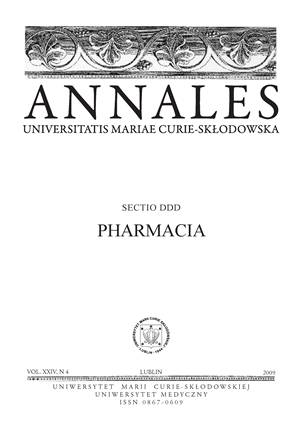Determination of aucubin in aerial parts of Buddleja davidii Franch. using different TLC-detection methods
Abstract
In the present study a quantitative analysis of the content of aucubin in Buddleja davidii Franch. was performed. The experiment was based on the colour reaction between iridoids and 1% solution of 4-dimethylaminobenzaldehyde in ethanol and 36% hydrochloric acid. Iridoids were visualized on the HPTLC plate and their content was measured by means of classical TLC densitometer and videodensitometer. The quantitative determination was carried out comparing peak area or peak height with standard aucubin solution. The classical densitometry resulted in 1.05% (measured from peak height) and 1.21 (measured from peak area) of aucubin in dry mass of aerial parts of Buddleja davidii and was about 10% higher than video densitometry concentrations.
References
1. Andrzejewska-Golec E.: Farm. Pol. 51, 435, 1995.
2. Biringanine G., Chiarelli M. T., Faes M., Duez P.: Talanta, 69, 418, 2006
3. ChangI. M.: Res. Commun. Mol. Pathol. Pharmacol., 102, 189, 1998.
4. Chen S. B., Liu H. P., Tian R. T. et al: J. Chromatogr., A 1121, 114, 2006.
5. Davini E., Iavarone C., Trogolo C.: Phytochemistry, 25, 2420, 1986.
6. Dinda B., Debnath S., Harigaya Y.: Chem. Pharm. Bull., 55, 159, 2007.
7. Farmakopea Polska VII, URPLWM iPB, Warsaw 2006.
8. Farmakopea Polska VIII, URPLWMiPB, Warsaw 2008.
9. Galvez M., Mar t in-Cordero C., Ayuso M. J.: J. Enzyme Inhib. Med. Chem., 20, 389, 2005.
10. Haznagy-Radnai E., Leber P., Toth E. et al.: J. Planar Chromatogr., 18, 314, 2005.
11. Ho J.N., Lee Y. H., Park J. S. et al.: Biol. Pharm. Bull., 28, 1244, 2005.
12. Jeong H. J., Koo H.N., Na H.J. et al.: Cytokine, 18, 252, 2002.
13. Jurisić R., Debeljak Z., Knazevic S. V. et al.: Z Naturf., 59c, 27, 2004.
14. Kim D.H., Kim B. R., Kim J.Y. et al.: Toxicol. Lett., 114, 181, 2000.
15. Kostecka-Mądalska O., Rymkiewicz A.: Acta Polon. Pharm., 31, 221, 1974.
16. Krzek J., Janeczko Z., Walusiak D. et al.: J Planar Chromatogr., 15, 197, 2002.
17. Lee D. H., Cho I. G., Park M. S. et al.: Arch. Pharm. Res., 24, 55, 2001.
18. Nieminen M., Suomi J., Van Nouhuys S. et al.: J. Chem. Ecol., 29, 823, 2003.
19. Matysik G., Toczołowski J.: Chem. Anal., 42, 221, 1997.
20. Ortiz de Urbina A. V., Mar t in M. L., Fernandez B. et al.: Planta Med., 60, 512, 1994.
21. Park K. S., Chang I. M.: Planta Med., 70, 778, 2004.
22. Recio M. C., Giner R. M., Manez S. et al.: Planta Med., 60, 232, 1994.
23. Sesterhenn K., Dist l M., Wink M.: Plant Cell Rep., 26, 365, 2007.
24. Suomi J., Siren H., Hartonen K. et al.: J. Chromatogr., A 868, 73, 2000.
25. Suomi J., Wiedmer S.K., Jussila M. et al.: Electrophoresis, 22, 2580, 2001.
26. Świątek L., Drużyński J.: Acta Polon. Pharm., 6, 597, 1968.
27. Trim A. R., Hill R.: Biochem. J., 50, 310, 1952.
28. Wagner H., Bladt S.: Plant drug analysis, p.88, Springer, 1996.
29. Wolski T., Pszczoła D., Baj T.: Post. Fitoter., 2, 75, 2006.
Downloads
Published
Issue
Section
License
Copyright (c) 2009 Authors

This work is licensed under a Creative Commons Attribution-NonCommercial-NoDerivatives 3.0 Unported License.


